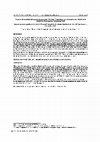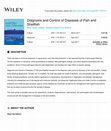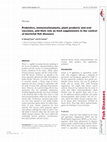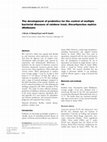Papers by Aweeda Newaj-Fyzul
Fish Biology and Characteristics, 2017

Atmospheric Measurement Techniques Discussions, 2012
A technique for collecting aerosol particles between altitudes of 85 and 17 km is described. Coll... more A technique for collecting aerosol particles between altitudes of 85 and 17 km is described. Collection probes are ejected from a sounding rocket allowing for multi-point measurements. Each probe is equipped with 110 collection samples that are 3 mm in diameter. The collection samples are one of three types: standard transmission electron microscopy carbon grids, glass fibre filter paper or silicone gel. Each collection sample is exposed over a 50 m to 5 km height range with a total of 45 separate ranges. Post-flight electron microscopy gives size-resolved information on particle number, shape and elemental composition. Each collection probe is equipped with a suite of sensors to capture the probe's status during the fall. Parachute recovery systems along with GPS-based localization ensure that each probe can be located and recovered for post-flight analysis.

Boletín Científico de la Escuela Superior Atotonilco de Tula, 2017
A pesar de la regulación de las aguas residuales, estas van en aumento. Su principal impacto es l... more A pesar de la regulación de las aguas residuales, estas van en aumento. Su principal impacto es la contaminación de los mantos freáticos por filtración natural como parte del ciclo del agua, ya que estas ejercen enorme presión en la mayor parte de los cuerpos superficiales de México a través de materia orgánica, sodios, grasas, aceites, pesticidas y una amplia variedad de sustancias químico-biológicas entre ellas los hidrocarburos constituyen el problema más generalizado. En materia de gestión ambiental, en México ha habido un desfase entre la emisión de la legislación ambiental y la creación de instituciones que tuvieran como prioridad la aplicación de esta legislación. Es así como las aguas residuales se convierten en un verdadero problema de salud pública, su gestión al respecto resulta fundamental para generar un entorno ambiental saludable, la seguridad alimentaria, la salud y el desarrollo económico.
Veterinary Microbiology, 2010

Journal of Food Agriculture and Environment
The management practices and water quality of 28 selected fish farms in Trinidad were evaluated. ... more The management practices and water quality of 28 selected fish farms in Trinidad were evaluated. A survey of the farms showed that the most popular species were the guppy (Poecilia reticulata), molly (Poecilia sphenops) and helleri (Xiphophorus hellerii) each on 13 (46.4%) of 28 farms. Of a total of 17 species reared, 15 (53.6%) of the 28 farms reared 5 species at a time. Pipeborne water supply provided by the government was the only source to 15 (53.6%) farms while the remaining 13 (46.4%) farms used water from a combination of sources (pipe borne, rain and groundwater). Eighteen (64.3%) of the farms did not treat their water, while 22 (78.6%) and 24 (85.7%) farms practised quarantine and isolation respectively. Nineteen (67.9%) farms used antimicrobial agents to treat their stock with methylene blue and oxytetracycline either alone or in combination. Twenty-two (78.6%) farms have experienced fish kills since their inception and 13 (46.4%) experienced fish kills in either a single ...
Journal of Nutrition & Food Sciences, 2012

There has been a continual expansion in aquaculture, such that total production is fast approachi... more There has been a continual expansion in aquaculture, such that total production is fast approaching that of wild-caught fisheries. Yet the expansion is marred by continued problems of disease. New pathogens emerge, and others become associated with new conditions. Some of these pathogens become well established, and develop into major killers of aquatic species. Diagnosis and Control of Diseases of Fish and Shellfish focuses on the diagnosis and control of diseases of fish and shellfish, notably those affecting aquaculture. Divided into 12 chapters, the book discusses the range of bacterial, viral and parasitic pathogens, their trends, emerging problems, and the relative significance to aquaculture. Developments in diagnostics and disease management, including the widespread use of serological and molecular methods, are presented. Application/dose and mode of action of prebiotics, probiotics and medicinal plant products used to control disease are examined, as well as the management and hygiene precautions that can be taken to prevent/control the spread of disease. This book will be a valuable resource for researchers, students, diagnosticians, veterinarians, fish pathologists and microbiologists concerned with the management of diseases of fish and shellfish.
Ornamental fish and pond water samples from 17 ornamental fish farms in Trinidad were cultured fo... more Ornamental fish and pond water samples from 17 ornamental fish farms in Trinidad were cultured for Salmonella spp. following enrichment of fish slurry and water samples. The antibiotic sensitivity of Salmonella isolates was determined by the disc diffusion method. Of the 560 fish sampled, 13 (2.3%) were positive for Salmonella spp. while only one (0.9%) of 111 pond water cultured was contaminated by the pathogen. Of a total of 14 isolates of Salmonella, 13 (92.8%) were S. javiana and 1 (7.2%) was S. aberdeen. Isolates were least resistant to sulphamethoxazole trimethoprim (7.1%) and norfloxacin (7.1%) while they were most resistant to oxytetracycline (78.6%) and neomycin (100%). The presence of antibiotic resistant Salmonella present in ornamental fish and their pond waters may constitute a public health hazard.

Annals of the New York Academy of Sciences, 2008
Arthropod-borne diseases are important causes of morbidity and mortality of companion animals in ... more Arthropod-borne diseases are important causes of morbidity and mortality of companion animals in Trinidad. As clinical signs are vague, more sensitive methods to diagnose these diseases based on the polymerase chain reaction (PCR) followed by reverse line blot hybridization (RLB) of amplified products are being developed. An RLB of 14 oligonucleotide probes coupled with polymerase chain-amplified regions of 16S rRNA or 18S rRNA genes of hemoparasites from cats and dogs detected Ehrlichia canis, Anaplasma platys, Babesia canis vogeli, feline mycoplasmas ("Candidatus Mycoplasma haemominutum,"Mycoplasma haemofelis), and some unknown species within the Babesia/Theileria group and the Anaplasma/Ehrlichia tribe. Amplified products were obtained from blood samples collected from 348 dogs and 15 cats. Overall, hemopathogen DNA was detected in 92 (26.4%) dogs and six (40.0%) cats. E. canis (49, 14.1%) and feline mycoplasma (5, 33.3%) DNA were most frequently identified in dogs and cats, respectively. B. canis vogeli (1, 6.7%) and E. canis (1, 6.7%) were also detected in cats. Mixed infections of Anaplasma/Ehrlichia sp. and Babesia sp. were present in five (1.4%) dogs, while mixed infections of the feline mycoplasmas were present in two (13.3%) cats, one of which was also positive for E. canis. Pyrexia was significantly associated with a positive RLB result in dogs (P= 0.00, chi(2), 1 df). This is the first reported application of macro-arraying techniques to detect arthropod-borne hemopathogens of companion animals in the Americas and the first detection of DNA of B. canis vogeli and E. canis in cats in Trinidad.

Journal of Fish Diseases, 2014
There is a rapidly increasing literature pointing to the success of probiotics, immunostimulants,... more There is a rapidly increasing literature pointing to the success of probiotics, immunostimulants, plant products and oral vaccines in immunomodulation, namely stimulation of the innate, cellular and/or humoral immune response, and the control of bacterial fish diseases. Probiotics are regarded as live micro-organisms administered orally and leading to health benefits. However, in contrast with the use in terrestrial animals, a diverse range of microorganisms have been evaluated in aquaculture with the mode of action often reflecting immunomodulation. Moreover, the need for living cells has been questioned. Also, key subcellular components, including lipopolysaccharides, have been attributed to the beneficial effect in fish. Here, there is a link with immunostimulants, which may also be administered orally. Furthermore, numerous plant products have been reported to have health benefits, namely protection against disease for which stimulation of some immune parameters has been reported. Oral vaccines confer protection against some diseases, although the mode of action is usually linked to humoral rather than the innate and cellular immune responses. This review explores the relationship between probiotics, immunostimulants, plant products and oral vaccines.
Zoonoses and Public Health, 2008

Journal of Fish Diseases, 2007
JB-1 and GC2, which were equated with Bacillus sp. and Aeromonas sobria respectively, were recove... more JB-1 and GC2, which were equated with Bacillus sp. and Aeromonas sobria respectively, were recovered from the digestive tract of rainbow trout, Oncorhynchus mykiss and ghost carp, Cyprinus sp. respectively, and demonstrated effectiveness as probiotics for the control of infections caused by Aeromonas salmonicida, Lactococcus garvieae, Streptococcus iniae, Vibrio anguillarum, Vibrio ordalii and Yersinia ruckeri. When administered to rainbow trout (average weight = 12 g) for 14 days in feed dosed at 2 · 10 8 cells g )1 of feed, JB-1 led to a reduction in mortalities to 0-13% after challenge with a range of bacterial pathogens compared to 80-100% mortalities of the controls. Similarly, use of GC2 reduced mortalities to 0-16% following the challenge compared to 80-100% mortalities of the controls. The mode of action reflected nutrition, production of inhibitory substances and stimulation of the innate immune responses. Specifically, JB-1 and especially GC2 were positive for siderophore and chitinase production, and increased lysozyme, phagocytic and respiratory burst activity.
Journal of Applied Microbiology, 2007
Annals of the New York Academy of Sciences, 2008
A reverse line blot hybridisation (RLB) of 21 oligonucleotides with polymerase chain reaction (PC... more A reverse line blot hybridisation (RLB) of 21 oligonucleotides with polymerase chain reaction (PCR) amplified regions of 16S rRNA (Ehrlichia/Anaplasma group) or 18S rRNA (Babesia/ Theileria group) genes of haemoparasites detected Theileria annulata, T. buffeli/orientalis, Babesia bovis, B. bigemina, B. divergens, Ehrlichia bovis, Anaplasma marginale, A. centrale and unknown species within the Rickettsia tribe.
Veterinary Microbiology, 2010
Two canine haemoplasma species have been recognised to date; Mycoplasma haemocanis (Mhc), which h... more Two canine haemoplasma species have been recognised to date; Mycoplasma haemocanis (Mhc), which has been associated with anaemia in splenectomised or immunocompromised dogs, and "Candidatus Mycoplasma haematoparvum" (CMhp), recently described in an anaemic splenectomised dog undergoing chemotherapy. The study aim was to develop quantitative real-time PCR assays (qPCRs) incorporating an endogenous internal control to detect Mhc and CMhp and to apply these assays to DNA samples extracted from canine blood collected in Northern Tanzania (n = 100) and from dogs presented to a Trinidadian veterinary hospital (n = 185).
Teaching Documents by Aweeda Newaj-Fyzul
beahavior of Fishes, 2017
PESCADO Project: Caribbean Aquaculture and Aquaponics, 2017







Uploads
Papers by Aweeda Newaj-Fyzul
Teaching Documents by Aweeda Newaj-Fyzul